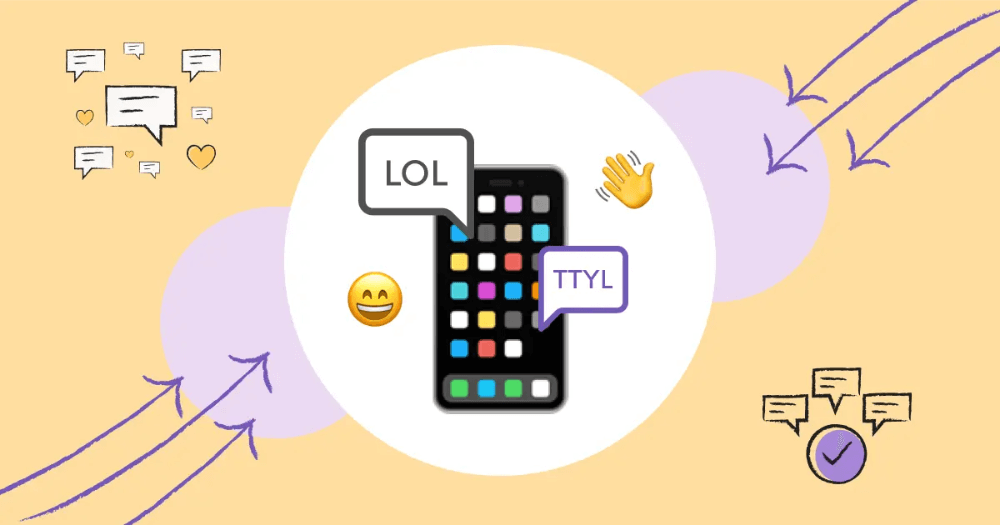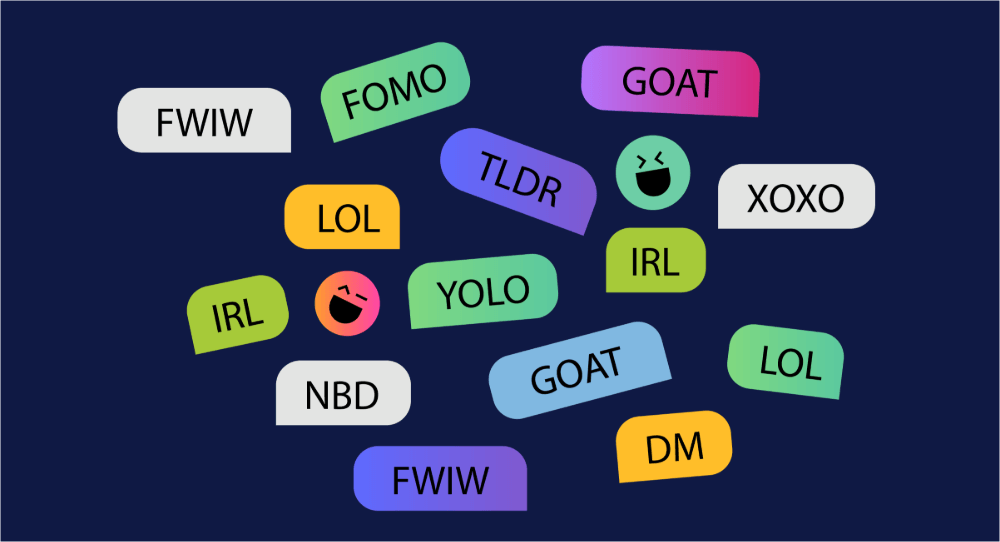📑Table of Contents:
- Why Text Abbreviations Matter in SMS Marketing
- The Benefits of Using Abbreviations
- Risks of Using Abbreviations Incorrectly
- The 117 Most Common Text Abbreviations
- When to Use Abbreviations
- When Not to Use Abbreviations
- Creating a Style Guide for Abbreviation Use
- Balancing Tone, Clarity, and Brand Voice
- How Abbreviations Affect Engagement
- Best Practices for Using Abbreviations in SMS Marketing
- The Future of SMS Language
- Conclusion

Texting has become a universal language. From teens chatting to brands promoting offers, abbreviations fill every message. Yet, while shorthand can save time and space, it can also cause confusion or even harm your professional image. This post explores 117 popular text abbreviations, how to use them effectively, and when not to.
Why Text Abbreviations Matter in SMS Marketing
Abbreviations make your texts shorter and snappier. They also help your brand sound more conversational and relatable. However, context is everything. A playful “LOL” may suit a casual retail promo but can appear unprofessional in a healthcare reminder.
When used well, abbreviations boost engagement. They reduce friction, helping your audience grasp your message instantly. Yet, when overused or misunderstood, they can damage clarity and trust.
The Benefits of Using Abbreviations
- Efficiency: You get your message across faster.
- Tone: They make your texts sound more human.
- Engagement: Short, catchy words increase response rates.
- Cost: You save characters in SMS messages, cutting costs.
However, these benefits work only if your recipients understand the abbreviations.
Risks of Using Abbreviations Incorrectly
- Misinterpretation: Not everyone knows what “ICYMI” means.
- Unprofessional tone: Some shorthand can appear lazy.
- Brand inconsistency: Using too many slang terms can dilute your voice.
- Compliance issues: Misleading abbreviations may violate communication standards.
So, while abbreviations are powerful, they must align with your brand’s tone, industry, and audience expectations.
The 117 Most Common Text Abbreviations
Let’s explore the abbreviations you’ll encounter most often.
Common Everyday Abbreviations
- LOL – Laugh Out Loud
- BRB – Be Right Back
- BTW – By The Way
- IDK – I Don’t Know
- OMG – Oh My God
- TTYL – Talk To You Later
- IMO – In My Opinion
- IMHO – In My Humble Opinion
- FYI – For Your Information
- ASAP – As Soon As Possible
- THX – Thanks
- TY – Thank You
- NP – No Problem
- YW – You’re Welcome
- BFF – Best Friends Forever
- NBD – No Big Deal
- JK – Just Kidding
- ROFL – Rolling On the Floor Laughing
- DM – Direct Message
- TBH – To Be Honest
Marketing & Business Abbreviations
- CTA – Call To Action
- ETA – Estimated Time of Arrival
- EOD – End Of Day
- FYR – For Your Reference
- ROI – Return On Investment
- KPI – Key Performance Indicator
- FAQ – Frequently Asked Questions
- TBA – To Be Announced
- TBC – To Be Confirmed
- FOMO – Fear Of Missing Out
- BOGO – Buy One Get One
- OOO – Out Of Office
- PLS – Please
- RSVP – Please Respond
- NRN – No Reply Necessary
Customer Engagement Abbreviations
- TYT – Take Your Time
- GR8 – Great
- CUL8R – See You Later
- ICYMI – In Case You Missed It
- LMK – Let Me Know
- WFH – Work From Home
- TGIF – Thank God It’s Friday
- IDC – I Don’t Care
- LMAO – Laughing My A** Off
- XO – Hugs and Kisses
Industry-Specific Abbreviations
- VIP – Very Important Person
- SZN – Season
- BFCM – Black Friday Cyber Monday
- MSRP – Manufacturer’s Suggested Retail Price
- ETA – Estimated Time of Arrival
Healthcare:
- RX – Prescription
- OTC – Over The Counter
- NPO – Nothing By Mouth
- FU – Follow-Up
- BP – Blood Pressure
Real Estate:
- FSBO – For Sale By Owner
- HOA – Homeowners Association
- MLS – Multiple Listing Service
- TBD – To Be Determined
Fun and Trendy Abbreviations
- TMI – Too Much Information
- IKR – I Know, Right?
- ICY – In Case You’re Wondering
- SMH – Shaking My Head
- YOLO – You Only Live Once
- IDGAF – I Don’t Give A Fig (or a stronger version)
- AF – As Fantastic (or another variation)
- RN – Right Now
- TL;DR – Too Long; Didn’t Read
- STFU – Silence That Funny Utterance (playfully toned)
These abbreviations evolve fast. What’s trending this year might fade next year, so staying current helps you sound modern, not outdated.
When to Use Abbreviations
You should use abbreviations when:
- Your message is casual or promotional.
- You’re talking to younger audiences.
- Space is limited (e.g., 160-character SMS).
- The abbreviation is widely understood.
For example, “BOGO sale ends tonight! Shop now & save big 💸” sounds friendly and concise.
When Not to Use Abbreviations
Avoid abbreviations when:
- You’re sending official or compliance-related texts.
- The audience is unfamiliar with slang.
- The abbreviation may be misread or offensive.
- Clarity matters more than brevity.
For instance, “Your appointment is tmrw @ 3PM. Pls confirm.” works, but “Your appt tmrw @3 ok?” feels rushed or unprofessional.
Creating a Style Guide for Abbreviation Use
To maintain brand consistency, develop internal rules. Your SMS team should know:
- Which abbreviations are acceptable.
- When to use them (e.g., marketing vs. transactional).
- Tone boundaries (fun vs. formal).
- Spelling standards (no mixed capitalization).
This helps your texts remain consistent even when multiple team members write them.
Balancing Tone, Clarity, and Brand Voice
Your goal is to sound approachable yet clear. Use abbreviations to add warmth, not confusion. Combine shorthand with full words for balance. For example, “FYI—sale ends at midnight!” works better than “FYI sale end @ 12AM!”
Always remember: clarity beats coolness.
How Abbreviations Affect Engagement
Well-placed shorthand can boost engagement by up to 30%. Readers respond faster when messages feel conversational. However, if they have to decode your message, engagement drops.
Therefore, test different variations. A/B test messages like:
- “BOGO deal—2 for 1 today only!”
- “Buy 1 Get 1 Free—ends soon!”
Measure which one gets more clicks.
Best Practices for Using Abbreviations in SMS Marketing
- Use abbreviations your audience already knows.
- Test before rolling out campaigns widely.
- Keep the message tone consistent with your brand.
- Avoid using more than two abbreviations per text.
- Ensure accessibility for all demographics.
These small adjustments improve readability and professionalism.
The Future of SMS Language
As AI and predictive text evolve, abbreviation use may change. Smart messaging platforms can already expand or clarify slang automatically. Yet, brands that maintain authenticity—without overdoing shorthand—will stand out.
AI tools may soon help marketers personalize tone dynamically. You might send formal messages to professionals and casual ones to Gen Z—all from the same workflow.

Conclusion
Text abbreviations make SMS marketing faster, lighter, and more conversational. However, they’re not a shortcut for poor communication. Knowing when to use them—and when to skip them—keeps your brand credible and engaging.
In short, abbreviations are tools, not tricks. Use them wisely to balance speed with sincerity, and your messages will connect more meaningfully with every audience segment.
